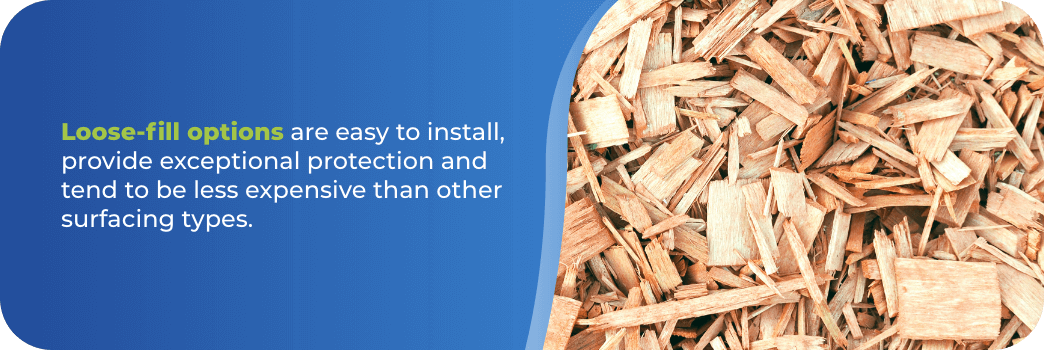Picture a playground in your mind. What does the floor look like under the equipment? Most likely, you visualized rubber mulch, sand, wood chips or a similar material. This is known as playground surfacing, which serves a specific purpose for commercial outdoor playgrounds. When it comes to choosing surfacing options, just as with choosing play equipment, it matters which material you choose.
Your playground will likely be located in a public area where kids of all ages and abilities will come to play, imagine and explore. It’s important to install a playground surface material that provides plenty of cushion and protection while adding to the aesthetic of your new play area. In this article, we’ll review why playground surfacing is so important for commercial playgrounds and the different materials you can use for surfacing.
Playground surfacing, sometimes referred to as safety surfacing, is the material used underneath play equipment, such as play sets, swings, slides and monkey bars. This material usually comes from rubber, wood, sand, pea gravel or another type of recyclable product.
Playground surfacing adds a padded level between play equipment and the ground to provide a soft place for children to land when they walk, crawl or jump. Most importantly, playground surfacing acts as a protective layer on the ground in case of accidental falls or injuries.
In the United States, more than 205,000 children under the age of 16 experience injuries on a playground annually. The majority of these injuries involve unsafe surfacing, which emphasizes the important role that proper playground surfacing plays in preventing severe injuries like concussions, dislocations, fractures and internal injuries.
Due to the frequency of these injuries, the Consumer Product Safety Commission (CPSC) issued specific standards for public playground surfacing. With at least 12 inches of proper playground surfacing, children’s injuries may be significantly reduced or avoided compared to if they were to fall on hard, unpadded ground, such as concrete or asphalt.
Additionally, playground surfacing is critical for meeting guidelines set by the Americans with Disabilities Act (ADA). Navigating a playground with surfacing material like sand can make it impossible for children and adults who use mobility devices, such as wheelchairs and walkers, to participate. Installing playground surfacing that works for everyone can promote inclusivity and meet accessibility standards.
Playgrounds can be located in many public places, such as shopping malls, campgrounds, apartment complexes and schools. Because different types of playground surfacing can be used in any of these places, it’s important to consider which is the most suitable for your outdoor location.
When choosing the right playground surface material, it’s important to consider the various types, materials and factors that can influence your decision. Your playground likely has some unique requirements, which means it can be a challenge to determine which type of surfacing is best for the children who will be playing on it. In some cases, one surface type may not meet all the needs you had in mind for your playground project.
Choosing the right playground surfacing depends on many different factors, including:
Before you decide on a type of surface, it’s important to keep these variables in mind and weigh the benefits and drawbacks of each material. When it comes down to it, safety should always be the top priority when choosing a playground surface. Fortunately, plenty of options exist that can fit your budget requirements, meet your design goals and comply with ADA regulations for accessibility and inclusivity.
There are several styles of playground surfacing to consider. Below, we’ll assess how these types of surfacing differ and the pros and cons of each material to help guide your decision.
Loose-fill materials are a common choice for many playgrounds because they come in a few options — rubber, wood fiber or mulch.

Pour-in-place is another popular surfacing type for playgrounds due to its smooth, cushioned surface, high durability and low maintenance use. Pour-in-place is ideal for playgrounds and walking trails because of its ability to withstand heavy foot traffic and custom color and design options.
Bonded rubber surfacing is an eco-friendly option that consists of rubber tiles that fit together in place to make one solid, seamless surface. This type of surfacing is ideal for playgrounds and public parks because it provides a smooth surface for playing or walking.
Turf surfacing works well as an alternative to real grass for those who love the look and feel of natural grass without the maintenance and wear over time. Turf is ideal for sports fields due to its similarity to real grass, but it can also work well on outdoor playgrounds and provide a natural, vibrant appearance.
Playground surfacing can change the visual appeal, accessibility and safety of your playground. It’s important to choose the right option and ensure children can enjoy your play equipment and engage in physical activity while being supported by a protective, comfortable surfacing. At Playworx, we can help you decide which long-lasting material is ideal for your playground needs and budget.
Our playground specialists will walk you through our various products and discuss the specifications of your playground equipment to determine which material will combine well with your design. All of our products are ADA accessible and meet ASTM and CPSC standards for safety surfacing. Whether you want a simple wood fiber surfacing or something vibrant and colorful, Playworx has everything you need to create the ultimate play experience.
Get in touch with us today or view our project gallery to learn more about how Playworx provides fun that lasts!